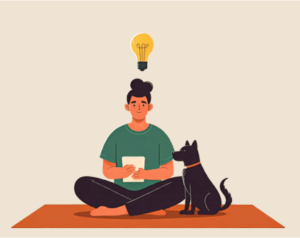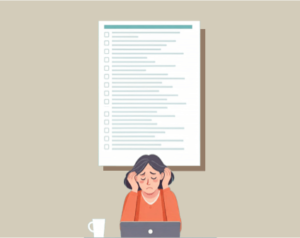As winter swoops in with its icy hug, our daydreams drift to lazy mornings and Netflix marathons under cosy blankets. Have you ever felt your energy drop when the cold sets in? Lots of people think winter slows them down. But there’s more to how winter affects us than you might think. It’s crucial to understand why it happens. There’s also a sneaky culprit that often goes unnoticed: Seasonal Affective Disorder, or SAD. Let’s dive into this seasonal challenge together and uncover its impact on our motivation and focus!
What is Seasonal Affective Disorder (SAD)?
Seasonal Affective Disorder isn’t just a fleeting mood—it’s a recognized form of depression that operates on a seasonal rhythm. While it can manifest in any season, SAD predominantly casts its shadow during winter months. According to science, a considerable segment of the population experiences some degree of SAD as daylight becomes a scarce commodity. So, if you’ve ever felt like winter dampens your spirits more than most, you’re not alone.
Beyond the occasional winter blues, individuals grappling with SAD often encounter persistent feelings of sadness and a noticeable loss of interest in activities they once cherished. But here’s where it gets intricate: SAD doesn’t merely cloud your emotional landscape. It seeps into your daily routine, sapping your energy and zeal. Picture navigating a maze while wearing foggy goggles—that’s akin to the uphill battle many face when SAD takes hold. Your motivation dwindles, your focus falters, and suddenly, tasks that once felt manageable become daunting challenges.
Now, you might wonder, “How does SAD’s winter-induced haze translate into tangible productivity setbacks?” The answer lies in compelling research findings that spotlight a direct correlation between SAD and decreased productivity levels. Studies reveal that individuals wrestling with SAD often grapple with reduced efficiency, heightened absenteeism, and challenges concentrating on tasks at hand. In essence, SAD doesn’t merely cast a shadow on your mood; it intricately weaves its influence into your performance metrics, making even the simplest tasks feel like monumental endeavors.

Physical Challenges of Winter
The frosty season ushers in a unique array of physical challenges that demand our attention. Our bodies face a formidable trio: frigid air, reduced sunlight, and the occasional wrath of inclement weather. These elements create an environment that can upend our physical well-being. Imagine thermometers spiraling downwards, sunlight becoming a rare gem, and storms brewing with unpredictable fury. Suddenly, our beloved outdoor escapades take a backseat, and we find ourselves cocooned indoors more often than not. This shift in routine can be a breeding ground for challenges, including the lurking threat of illness and a decline in physical activity.
Ah, sunlight – that magical elixir that warms our spirits and fuels our bodies with the essential vitamin D. Winter, however, can be miserly with this precious resource. As sunlight exposure dwindles, so does our energy, paving the way for the winter blues to set in.
Now, let’s connect the dots between our physical well-being and productivity. When the winter chill creeps in, it’s not just the outdoor thermometer that plummets; our energy levels and overall health can take a nosedive too. So, let’s not forget to give our bodies the extra TLC they deserve. Winter may throw its challenges our way, but with a dash of awareness and a sprinkle of proactive habits, we can keep the cold at bay and dance through the season with joy.

Mental and Emotional Factors
About the mental and emotional factors that come into play during this season. Picture this: the snow-covered landscape outside, but inside, some may find themselves wrestling with feelings of isolation, loneliness, or the notorious cabin fever.
The psychological impact of winter is like a silent snowfall, gently settling on our minds and hearts. It’s not uncommon for these emotions to cast a shadow on our motivation, focus, and overall productivity. The winter blues, as some call it, can sneak into our daily lives, affecting our mental well-being in unexpected ways.
Combatting isolation and loneliness might involve reaching out to loved ones, whether through a cozy virtual chat or a winter-themed game night. A brisk winter walk or a playful snowball fight can work wonders for your mood. Understanding that the emotional factors of winter can impact motivation and focus, it’s time to get creative. Setting small, achievable goals and creating a warm and inviting workspace can reignite that dwindling spark of productivity.

Environmental Changes and Work Environment
Winter affects our environmental changes and work environment primarily due to reduced daylight hours, altering our circadian rhythm and potentially leading to fatigue and mood disruptions. Additionally, colder temperatures necessitate adjustments in indoor heating and ventilation systems, impacting air quality and comfort levels. These seasonal shifts can influence our psychological state, contributing to increased stress, reduced motivation, and productivity challenges.
To improve your work environment during winter, prioritize natural light exposure by positioning desks near windows or using light therapy lamps. Implement warm LED lighting to create a cozy atmosphere and reduce eye strain. Incorporating indoor plants and proper ventilation systems improves air quality, reducing dryness and potential health issues associated with prolonged indoor exposure.

Strategies to Boost Winter Productivity
While it may be tempting to hibernate during the winter months, staying physically active is a game-changer. Whether it’s a brisk walk, a home workout, or a dance session in your living room, moving your body releases those feel-good endorphins that combat the winter blues. And don’t forget to incorporate breaks into your day; they’re not just a luxury but a necessity. Short breaks can recharge your mind and enhance overall productivity.
Equally important is the emphasis on self-care. Nurture your body with proper nutrition, as a well-fed system is a well-functioning one. Ensure you’re getting adequate sleep to recharge your mind and body, setting the stage for a more energetic and productive day ahead. In the spirit of holistic well-being, it’s crucial to address mental health concerns that may arise during the winter, such as Seasonal Affective Disorder (SAD). If you find yourself struggling, don’t hesitate to seek support. Talking to friends, family, or a mental health professional can make a significant difference.

Books:
– “The Winter Blues: Everything You Need to Know to Beat Seasonal Affective Disorder” by Norman E. Rosenthal
– “The Power of Habit: Why We Do What We Do in Life and Business” by Charles Duhigg
– “Atomic Habits: An Easy & Proven Way to Build Good Habits & Break Bad Ones” by James Clear
Apps:
– Calm – Offers guided meditation, sleep stories, and relaxation techniques.
– Planndu – A productivity app to improve focus and stay productive during the day.
Articles:
“Improving Focus and Productivity Through Habits” – Link
“Top Science-backed Techniques To Boost Concentration” – Link
“How to Increase Focus Through Mindful Meditation” – Link
Websites/Organizations:
– National Institute of Mental Health (NIMH) – Link – Offers information and resources on mental health, including Seasonal Affective Disorder.
– Mayo Clinic – Seasonal Affective Disorder (SAD) – Link – Comprehensive information on SAD and its management.
Winter is more than just a season; it’s a unique set of challenges that can either make or break your productivity. Recognizing and addressing the distinctive challenges of winter is crucial for maintaining optimal productivity. Understanding these factors allows us to develop strategies to counteract them effectively. Winter may seem like a formidable opponent, but with the right mindset and approach, it becomes a season of opportunity rather than a hindrance.




